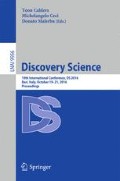Abstract
In this paper, we study the problem of classification of sequences of temporal intervals. Our main contribution is the STIFE framework for extracting relevant features from interval sequences to build feature-based classifiers. STIFE uses a combination of basic static metrics, shapelet discovery and selection, as well as distance-based approaches. Additionally, we propose an improved way of computing the state of the art IBSM distance measure between two interval sequences, that reduces both runtime and memory needs from pseudo-polynomial to fully polynomial, which greatly reduces the runtime of distance based classification approaches. Our empirical evaluation not only shows that STIFE provides a very fast classification time in all evaluated scenarios but also reveals that a random forests using STIFE achieves similar or better accuracy than the state of the art k-NN classifier.
Access this chapter
Tax calculation will be finalised at checkout
Purchases are for personal use only
Notes
- 1.
Implementation available at: https://github.com/leonbornemann/stife.
References
Giannotti, F., Nanni, M., Pedreschi, D.: Efficient mining of temporally annotated sequences. In: Proceedings of the 6th SIAM Data Mining Conference, vol. 124, pp. 348–359 (2006)
Höppner, F., Klawonn, F.: Finding informative rules in interval sequences. In: Hoffmann, F., Hand, D.J., Adams, N., Fisher, D., Guimaraes, G. (eds.) IDA 2001. LNCS, vol. 2189, pp. 125–134. Springer, Heidelberg (2001). doi:10.1007/3-540-44816-0_13
Kosara, R., Miksch, S.: Visualizing complex notions of time. Stud. Health Technol. Inform. 84, 211–215 (2001)
Kostakis, O., Gionis, A.: Subsequence search in event-interval sequences. In: Proceedings of the 38th International ACM SIGIR Conference on Research and Development in Information Retrieval, pp. 851–854. ACM (2015)
Kostakis, O., Papapetrou, P., Hollmén, J.: ARTEMIS: assessing the similarity of event-interval sequences. In: Gunopulos, D., Hofmann, T., Malerba, D., Vazirgiannis, M. (eds.) ECML PKDD 2011. LNCS (LNAI), vol. 6912, pp. 229–244. Springer, Heidelberg (2011). doi:10.1007/978-3-642-23783-6_15
Kotsifakos, A., Papapetrou, P., Athitsos, V.: IBSM: interval-based sequence matching. In: Proceedings of SIAM Conference on Data Mining, pp. 596–604 (2013)
Laxman, S., Sastry, P., Unnikrishnan, K.: Discovering frequent generalized episodes when events persist for different durations. IEEE Trans. Knowl. Data Eng. 19(9), 1188–1201 (2007)
Lin, J.L.: Mining maximal frequent intervals. In: Proceedings of the ACM Symposium on Applied Computing, pp. 624–629 (2003)
Mooney, C., Roddick, J.F.: Mining relationships between interacting episodes. In: Proceedings of the 4th SIAM International Conference on Data Mining (2004)
Pachet, F., Ramalho, G., Carrive, J.: Representing temporal musical objects and reasoning in the MusES system. J. New Music Res. 25(3), 252–275 (1996)
Papapetrou, P., Kollios, G., Sclaroff, S., Gunopulos, D.: Discovering frequent arrangements of temporal intervals. In: Proceedings of IEEE International Conference on Data Mining, pp. 354–361 (2005)
Papapetrou, P., Kollios, G., Sclaroff, S., Gunopulos, D.: Mining frequent arrangements of temporal intervals. Knowl. Inf. Syst. 21, 133–171 (2009)
Winarko, E., Roddick, J.F.: Armada - an algorithm for discovering richer relative temporal association rules from interval-based data. Data Know. Eng. 63(1), 76–90 (2007)
Wu, S.Y., Chen, Y.L.: Mining nonambiguous temporal patterns for interval-based events. IEEE Trans. Knowl. Data Eng. 19(6), 742–758 (2007)
Yang, Y., Pedersen, J.O.: A comparative study on feature selection in text categorization. ICML 97, 412–420 (1997)
Author information
Authors and Affiliations
Corresponding author
Editor information
Editors and Affiliations
Rights and permissions
Copyright information
© 2016 Springer International Publishing Switzerland
About this paper
Cite this paper
Bornemann, L., Lecerf, J., Papapetrou, P. (2016). STIFE: A Framework for Feature-Based Classification of Sequences of Temporal Intervals. In: Calders, T., Ceci, M., Malerba, D. (eds) Discovery Science. DS 2016. Lecture Notes in Computer Science(), vol 9956. Springer, Cham. https://doi.org/10.1007/978-3-319-46307-0_6
Download citation
DOI: https://doi.org/10.1007/978-3-319-46307-0_6
Published:
Publisher Name: Springer, Cham
Print ISBN: 978-3-319-46306-3
Online ISBN: 978-3-319-46307-0
eBook Packages: Computer ScienceComputer Science (R0)

